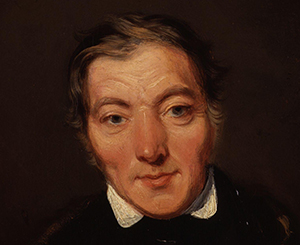November 07
Published in On this Day listing- 1831

Above: Robert Owen, whose ideas inspired the Ralahine Agricultural and Manufacturing Co-operative Association.
‘The transformation of conditions seemed a mystery to many. Social science was more successful than military force. Socialism could induce poor, ignorant Irish peasants to live in peace and harmony with each other. In their individualism, every man was for himself at the expense of every other person. Now each found his interest promoted by promoting the comfort and happiness of all around him.’The Ralahine Agricultural and Manufacturing Co-operative Association was launched by John Scott Vandeleur on his 618-acre estate near Bunratty, Co. Clare. Inspired by Robert Owen (1771–1858), the pioneer of the co-operative movement, Vandeleur hoped to discourage his tenants from joining agrarian secret societies, to encourage them to raise common capital—so that they could eventually purchase the estate—and to promote protection ‘against the evils of poverty, sickness, infirmity, and old age, the attainment of a greater share of the comforts of life than the working class now possess, the mental and moral improvement of the adult members and the education of their children’. Supervised by Englishman E.T. Craig, a devoted Owenite, the tenants—seven married couples along with their children, who attended a non-denominational community school, and 21 single men—elected a committee twice a year and instead of money used ‘labour notes’, which could be used in community stores. Marking their progressive outlook, they were the first in Ireland to use a reaping machine. As Craig himself wrote:
The spanner in the works, however, proved to be the landlord himself. An inveterate gambler, Vandeleur’s debts ran out of control just two years later and his creditors moved in. They seized the estate and sold the entire assets of the co-operative.
- 1969 Over 3,000 artefacts relating to the Vikings were discovered at the Winetavern Street/Wood Quay site of the proposed Dublin civic offices.
- 1968 Senator Margaret Pearse (90), sister of Patrick and Willie Pearse, died. She was accorded a state funeral.
- 1956 Faced with a UN Security Council resolution, backed by the United States and the USSR, British Prime Minister Sir Anthony Eden was forced to evacuate British troops from Suez.
- 1910 Leo Tolstoy (82), Russian novelist, author notably of War and Peace (1863–9) and Anna Karenina (1874–6), died of pneumonia in a siding at Astapovo railway station.
- 1881 John MacHale (90), archbishop of Tuam since 1834, writer and nationalist, died.
- 1867 Marie Curie, naturalised French physicist and chemist, born in Warsaw.
- 1809 Sir Patrick Dun’s Hospital, built as a teaching hospital for Trinity College, Dublin, with funds from a bequest of the physician Sir Patrick Dun (d. 1713), opened in Grand Canal Street, Dublin.
- 1975 Sir Patrick Dun’s Hospital, built as a teaching hospital for Trinity College, Dublin, with funds from a bequest of the physician Sir Patrick Dun (d. 1713), opened in Grand Canal Street, Dublin.
- 1972 President Richard Nixon was re-elected in a landslide some five months after the Watergate break-in, by then under intense investigation by Bob Woodward and Carl Bernstein of the Washington Post.
















